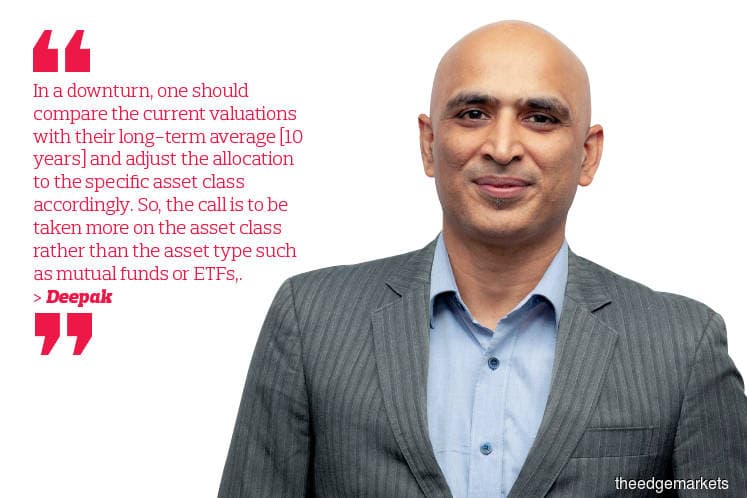
The introduction of leveraged and inverse exchange-traded funds (ETFs) in Malaysia late last year has provided investors with more options to protect their portfolios, says Deepak Khurana, performance director of fund ratings and distribution for Asia-Pacific at Refinitiv.
These tools are especially useful during a downturn. “Exotic products such as inverse ETFs use derivatives and allow investors to cover their downsides if they have a strong negative view of the market,” he says.
Currently, there are three inverse ETFs listed on the local bourse.
Inverse ETFs perform inversely to the indices they track, making them a popular tool among investors when the market crashes. These ETFs are also used as a hedge in a bear market, especially by investors with long positions.
Meanwhile, leveraged ETFs aim to achieve two to three times the returns of the indices they track. These are often used by investors with a tactical view of the market and who hope to magnify their exposure to a particular market.
However, such products should only be used for short-term trading in investors’ satellite portfolios, says Deepak. The core portfolio should be aligned to their long-term investment objectives.
This means the core portfolio should comprise a mix of asset classes. The selection of asset classes would depend on their relative performance.
“In a downturn, one should compare the current valuations with their long-term average [10 years] and adjust the allocation to the specific asset class accordingly. So, the call is to be taken more on the asset class rather than the asset type such as mutual funds or ETFs,” says Deepak.
According to a recent article by Lipper Research head Tom Roseen, passive funds have typically outperformed actively managed funds during periods of strong upward movements in the market. However, during periods of increased volatility and sector rotation, actively managed funds have outperformed their passive peers. This illustrates the importance of having a portfolio that has both active and passive funds, he wrote.
This could be particularly important for Malaysian investors to take note of as local ETFs are still in their infancy, says Deepak. These funds have not been able to outperform their actively managed peers yet.
He observes that actively managed Malaysian equity funds outperformed their ETF peers in four out of five years as at 2019. The exception was 2018, when all types of funds recorded negative average values. However, the ETFs’ decline was less than those of their actively managed peers.
This trend was observed in local ETFs tracking the Asean equity market as they also underperformed their actively managed peers. But the results were mixed for ETFs tracking the Chinese equity market as well as bond ETFs and their actively managed counterparts.
Nevertheless, the opposite was true for the first Malaysian ETF to track the US market, which was launched in 2019. “Last year, the outperformance of the Malaysian ETF tracking the US market was close to 35%, whereas active fund managers only achieved 25%,” says Deepak.
Growing the local ETF industry
Of the 1,200 funds in Malaysia — including unit trusts, pension funds and insurance funds — only 14 are ETFs, according to Deepak. The whole industry’s assets under management is close to RM100 billion, but only RM16 billion is invested in ETFs.
“ETF growth is dependent on not only retail investors but also large institutional investors. Pension funds globally have allocated significant amounts of money to ETFs. In Malaysia, we see pension funds allocating more to active funds,” says Deepak.
But institutional investors will only allocate more to ETFs if they see merit in the products. For instance, ETFs that track indices in developed markets such as the US have consistently outperformed active funds, making them an attractive option for investors. However, this has not been the case for ETFs tracking indices in emerging markets like Malaysia.
One reason for the outperformance of ETFs tracking the US market could be due to the transparency and availability of information on public-listed companies in the US, observes Deepak. “Active fund managers are not able to get any individual access to a market opportunity in the US. It is very hard for active fund managers to outperform passive funds, especially when it comes to large-cap companies,” he says.
Some studies have shown that companies with better disclosure practices and are more up front with investors and analysts tend to have better valuations. “The developed markets have mature and fully developed disclosure practices. So, you can get much stronger insights into the businesses and analysts can create better models of the companies’ future earnings,” says Deepak.
Developing countries and smaller economies tend not to have as much information transparency, he observes. Analysts in these countries may gain information on companies at management meetings and they tend to have better engagements with the leadership of those companies at a personal level.
“Active managers will always have an upper hand compared with passive funds. This is applicable to market capitalisation-based strategies as well. Larger companies are expected to have much more information and disclosure compared with small and mid-cap companies,” says Deepak, adding that ETFs here need to show better performance before they can be considered as an asset class by institutional investors and even robo-advisors.